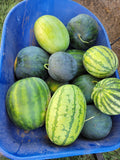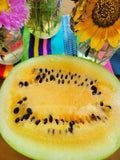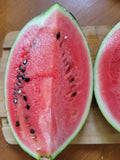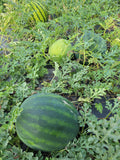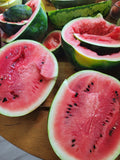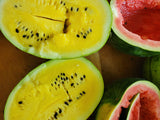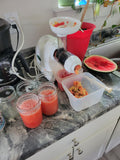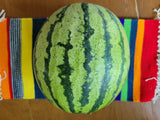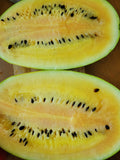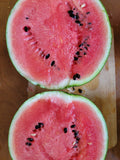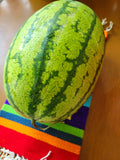Quick Facts:
- Short-season adapted
- Breeding-project ready- this population is diverse enough you can just plant and select those that grow the best for you to save seeds from
- Or make it more diverse by planting alongside your existing favorite varieties, allowing them to cross pollinate and saving seed from as many fruits as possible
- Each and every fruit is super duper tasty- no more tasteless watermelons!
- Requires less fertility than other watermelon varieties, great for organic gardens
Citrullus lanatus
60-85 days. A watermelon landrace is a great idea for every home gardener and I'll tell you why! With lots of genetic diversity, not every watermelon is going to be ripe at once, so you can pick and eat them progressively. Plus, the diversity of colors and flavors of this landrace are amazing, from yellow flesh, to orange and deep red, its so fun to be surprised by what lies inside each watermelon. Huge range of sizes, from 2-8 lbs. In your patch there's bound to be a perfect fit for a community gathering, or for one baby dinosaur.
This landrace was originally bred by our dear friend Joseph Lofthouse of Lofthouse Landrace Garden Seeds in Paradise, Utah. He was aiming for a short season specialty, so even though there is about a 6 week harvest window, all the watermelons ripen in a short season such as ours. Cool nights don't bother it, and these watermelons also thrive in low-input, low-fertility, and organic conditions.
Landraces are living breeding projects and we've added two of our short season favorites to this mix of cross-pollination: Blacktail Mountain and Chin Sun. We couldn't be happier with this diverse landrace and think you'll love it too!
Learn more about landrace crops in our blog post about it here.
How to Grow it:
|
Germ Temp |
Indoor Start |
Germ Days |
Frost Tolerant |
Sun |
Seed Depth |
Plant/Row Spacing |
|
70 |
4 weeks |
3-10 d. |
No |
Full |
1/2 inch |
48"/24" |
Watermelon seeds will not germinate at temperatures below 65 degrees. Start inside 4 weeks before last frost, but not sooner as larger plants don't transplant well. Alternatively, direct sow outside after all danger of frost has passed. Give them room to grow, with about 36" between plants on all sides. Watermelons are ripe when the underside of the skin is no longer yellow (this is called the "ground spot"), when they sound slightly hollow when thumped, and when the tendril that joins the main stem of the fruit to the vine is brown and dry.
If you do breed the next amazing plant variety, make sure its pledged open source so that all of humanity- not just a few corporate interests- can benefit from the common heritage that is resilient plant genetics! Joseph Lofthouse made sure this is an Open Source Seed Initiative pledged variety.
|
Seed specs: 2 g, ~30 seeds
|













